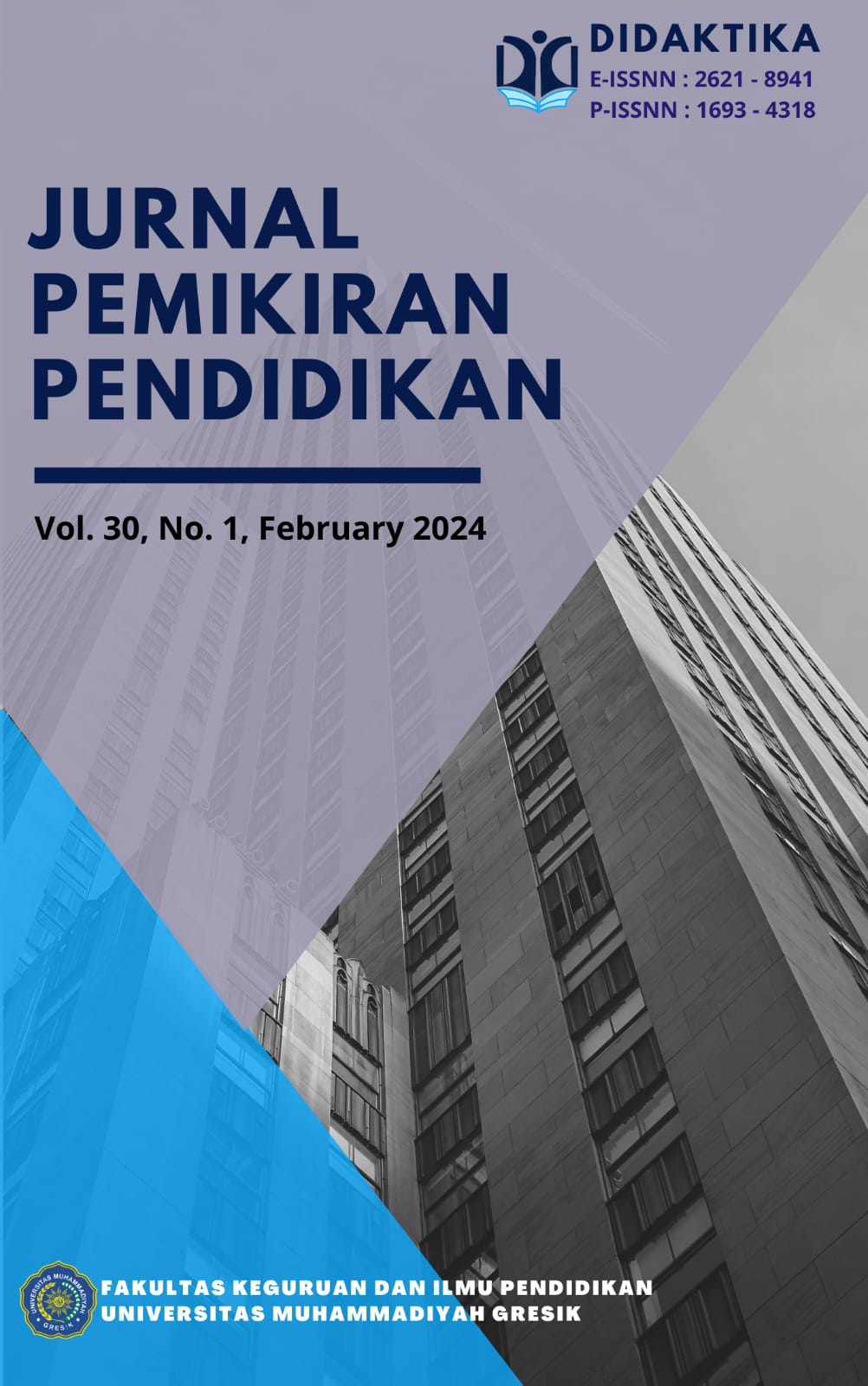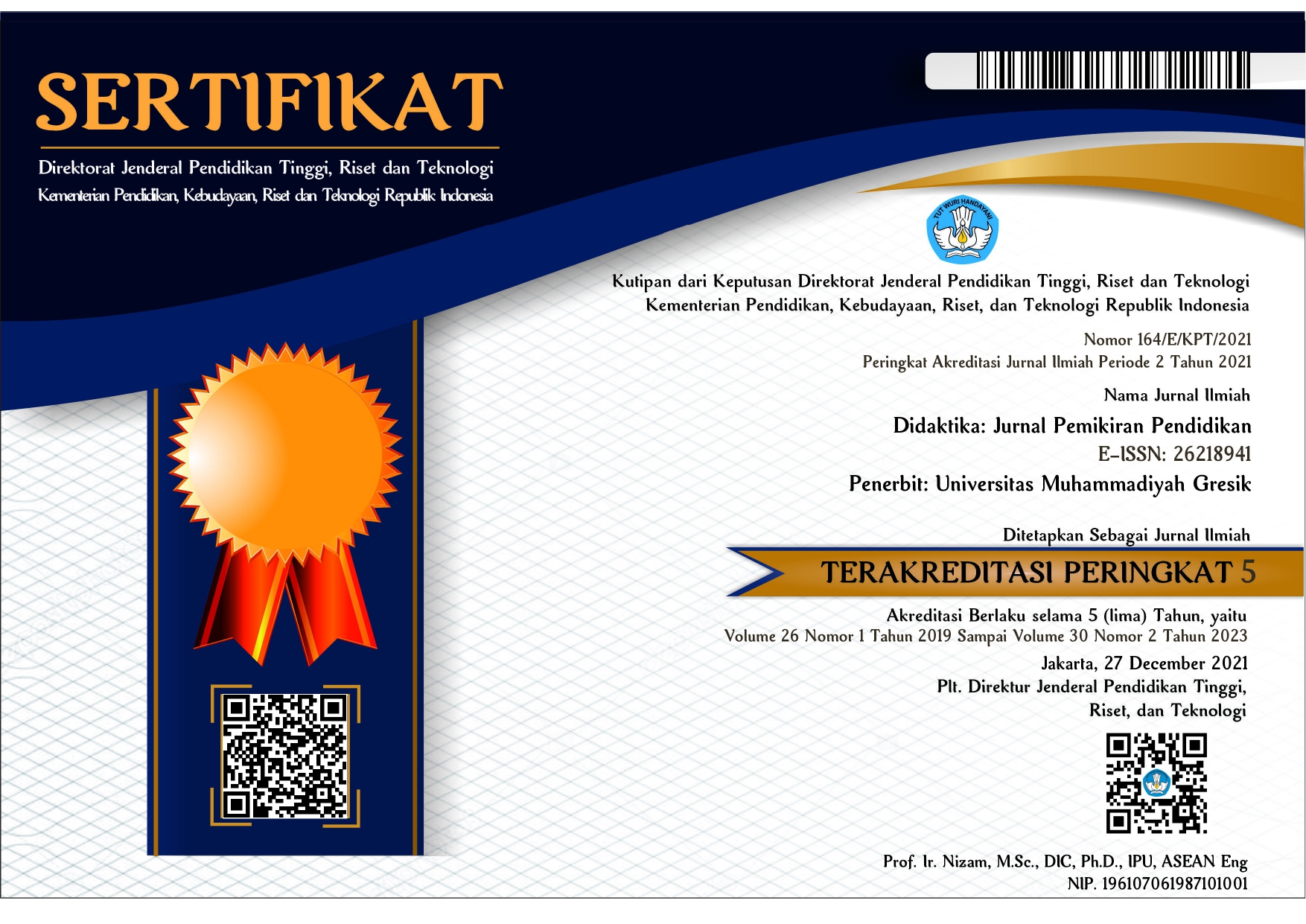iSpring on English Language Teaching and Learning: A Literature Review
A Literature Review
DOI:
https://doi.org/10.30587/didaktika.v30i1.7267Keywords:
English Language Teaching; English Language Learning; iSpringAbstract
iSpring is one of various software which is benefit in English language teaching and learning. There are numerous researches that bring up the use of iSpring to support the material and quiz development. This research aims at providing comprehensive literature review about iSpring in English language teaching and learning. This research’s objectives are investigating; 1) the roles of iSpring in English language teaching and learning and 2) the effectiveness of iSpring in English language teaching and learning. Qualitative research method with library research approach was used in this research. The data consists of 3 theses, 4 conference proceedings, 5 journal articles that taken mostly from Google Scholar. The data then analysed using content analysis to match the objective of this research. The findings showed that iSpring has several important roles for English language teaching and learning such as; making English teaching and learning activities becomes easier; helping students to learn English language; creating interest, motivation, confident, concentration, and independence for students in English learning; supporting all types of learning styles and various level of students in English learning; providing effective English teaching and learning activities; and also accommodating various English teaching methods. Besides that, this research also showed that iSpring was effective for foreign language distance learning, improving students’ independence on self-evaluation, improving receptive skill, and productive skills as well. Therefore, iSpring is suitable to be used in education, especially to support the English language teaching and learning.
References
Amali, L. N., Kadir, N. T., & Latief, M. (2019). Development of e-learning content with H5P and iSpring features Development of e-learning content with H5P and iSpring features. International Conference on Education, Science and Technology 2019, 1–6. https://doi.org/10.1088/1742-6596/1387/1/012019
Buda, A., Whai, M. K. G., & Neo, B. (2015). LEARNING ORAL PRESENTATION SKILLS USING ISPRING PRESENTER. Managing Transformation In Technology AndInnovation Globalization, 24–32. https://www.researchgate.net/publication/291974713_LEARNING_ORAL_PRESENTATION_SKILLS_USING_ISPRING_PRESENTER
Chang, M., & Lehman, J. D. (2002). Learning Foreign Language through an Interactive Multimedia Program: An Experimental Study on the Effects of the Relevance Component of the ARCS Model. CALICO Journal, 20(1), 81–98.
Daulay, F. S. (2022). THE USE OF HYPERMEDIA ISPRING SUITE 9 IN TEACHING READING COMPREHENSION ON RECOUNT TEXT [UNIVERSITAS NEGERI MEDAN].
Dumiyati, D., Wardhono, A., & Nurfalah, E. (2020). Dissemination of ICT-Based Learning Models to Improve Student Learning Independence in Higher Education. Proceedings of the First International Conference on Economics, Business and Social Humanities, ICONEBS 2020. https://doi.org/10.4108/eai.4-11-2020.2304584
Fitriati, F., & Megawati, F. (2021). iSpring Suite 9 : Its Effect on EFL Learners in Comprehending Narrative Text. Borneo Educational Journal (Borju), 3(2), 1–10. https://doi.org/10.24903/bej.v3i2.771
Haleem, A., Javaid, M., Qadri, M. A., & Suman, R. (2022). Understanding the role of digital technologies in education : A review. Sustainable Operations and Computers, 3(February), 275–285. https://doi.org/10.1016/j.susoc.2022.05.004
Indriyani. (2021). DEVELOPING GRAMMAR LEARNING MEDIA BY USING ISPRING SUITE 9 ON THE EIGHTH GRADE STUDENTS AT SMPN 3 TARAKAN. BORNEO TARAKAN UNIVERSITY.
Juraev, A. (2019). USING THE ISPRING SUITE SOFTWARE TO EVALUATE FUTURE TEACHERS’PROFESSIONAL COMPETENCIES. Central Asian Problems of Modern Science and Education, 4(2), 755–762.
Katermina, V. (2019). E-LEARNING IN THE FOREIGN LANGUAGE TEACHING CONTEXT. Proceedings of the International Scientific Conference, 3, 473–478. https://doi.org/http://dx.doi.org/10.17770/sie2019vol3.3721
Naeem, M. A. (2021). Designing a TEFL Mobile Application for EFL Teachers : An Empirical Study. Journal of Education, 6(91), 249–275. https://doi.org/10.21608/EDUSOHAG.2021.194555
Nigora, S., & Mukhtarova, Z. (2016). METHODOLOGY OF TEACHING ISPRING PROGRAM AND ITS PECULIARITIES. 3(3), 206–210. https://doi.org/https://doi.org/10.5281/zenodo.7739413
Nur, S., Butarbutar, R., Ardiningtyas, S. Y., & Alimuddin, A. H. (2022). A Systematic Review on Integrating MALL in English Language Teaching. Journal of English Language Teaching, 9(1), 56–69.
Qizi, S. Z. Z., & Alimovna, A. G. (2021). Ispring Suite And English Language Learning. International Journal of Engineering and Information Systems, 5(4), 286–287.
Rosanti, S., Alamhamdani, N., & Maskur. (2020). PENERAPAN MULTIMEDIA INTERAKTIF iSPRING SUITE 8 UNTUK MENINGKATKAN KETERAMPILAN BERBICARA DAN MENULIS BAHASA INGGRIS PADA POKOK BAHASAN OFFERING HELP DI SEKOLAH MENENGAH ATAS. Jurnal Teknologi Pendidikan Dan Pembelajaran, 5(1), 916–926.
Rusnawati, A. M. (2022). STUDENTS’ PERCEPTION TOWARDS ISPRING SUITE 9 AS AN ONLINE ASSESSMENT OF READING COMPREHENSION AT SMA ISLAM SULTAN AGUNG 1 SEMARANG. SULTAN AGUNG ISLAMIC UNIVERSITY.
Sarjono, D. (2008). Panduan Penulisan Skripsi. Jurusan Pendidikan Agama Islam.
Stepp-greany, J. (2002). STUDENT PERCEPTIONS ON LANGUAGE LEARNING IN A TECHNOLOGICAL ENVIRONMENT: IMPLICATIONS FOR THE NEW MILLENNIUM. Language Learning & Technology, 6(1), 165–180.
Wardhono, A., Hasyim, P. A. A., & Susatyo, B. (2022). THE SECOND SEMESTER STUDENTS’ RESPONSE TOWARDS THE USE OF ISPRING 8 IN LEARNING INTERMEDIATE ENGLISH GRAMMAR AT THE ENGLISH LANGUAGE EDUCATION STUDY PROGRAM. THE 11th RONGGOLAWE ENGLISH TEACHING CONFERENCE (RETCO), December, 17–23.
Zed, M. (2004). Metode Penelitian Kepustakaan. Yayasan Obor Indonesia.
Downloads
Published
How to Cite
Issue
Section
License
License and Copyright Agreement
In submitting the manuscript to the journal, the authors certify that:
- They are authorized by their co-authors to enter into these arrangements.
- The work described has not been formally published before, except in the form of an abstract or as part of a published lecture, review, thesis, or overlay journal.
- That it is not under consideration for publication elsewhere,
- That its publication has been approved by all the author(s) and by the responsible authorities – tacitly or explicitly – of the institutes where the work has been carried out.
- They secure the right to reproduce any material that has already been published or copyrighted elsewhere.
- They agree to the following license and copyright agreement.
Copyright
Authors who publish with DIDAKTIKA: Jurnal Pemikiran Pendidikan agree to the following terms:
- Authors retain copyright and grant the journal right of first publication with the work simultaneously licensed under a Creative Commons Attribution License (CC BY-SA 4.0) that allows others to share the work with an acknowledgment of the work's authorship and initial publication in this journal.
- Authors are able to enter into separate, additional contractual arrangements for the non-exclusive distribution of the journal's published version of the work (e.g., post it to an institutional repository or publish it in a book), with an acknowledgment of its initial publication in this journal.
- Authors are permitted and encouraged to post their work online (e.g., in institutional repositories or on their website) prior to and during the submission process, as it can lead to productive exchanges, as well as earlier and greater citation of published work.
Licensing for Data Publication
Open Data and Software Publishing and Sharing
The journal strives to maximize the replicability of the research published in it. Authors are thus required to share all data, code or protocols underlying the research reported in their articles. Exceptions are permitted but have to be justified in a written public statement accompanying the article.
Datasets and software should be deposited and permanently archived inappropriate, trusted, general, or domain-specific repositories (please consult http://service.re3data.org and/or software repositories such as GitHub, GitLab, Bioinformatics.org, or equivalent). The associated persistent identifiers (e.g. DOI, or others) of the dataset(s) must be included in the data or software resources section of the article. Reference(s) to datasets and software should also be included in the reference list of the article with DOIs (where available). Where no domain-specific data repository exists, authors should deposit their datasets in a general repository such as ZENODO, Dryad, Dataverse, or others.
Small data may also be published as data files or packages supplementary to a research article, however, the authors should prefer in all cases a deposition in data repositories.











